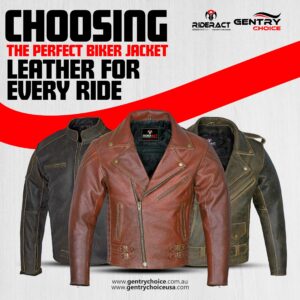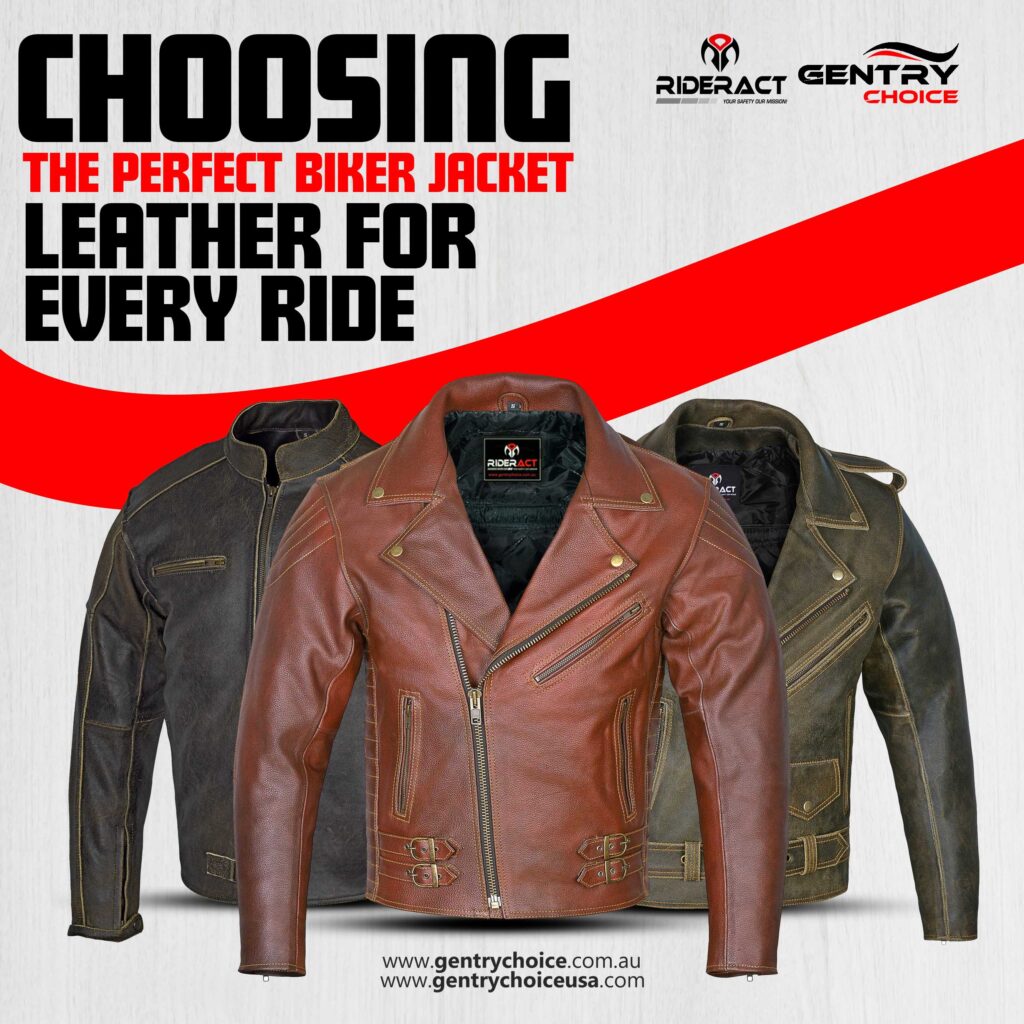Biker jackets have become iconic symbols of rugged style and protection. Whether you’re a weekend rider or a long-distance road warrior, choosing the right biker jacket is essential not only for your comfort but also for your safety. The primary material that makes a biker jacket stand out is leather. Known for its durability, comfort, and timeless appeal, leather Motorcycle jackets are a popular choice for riders. However, selecting the perfect one requires more than just aesthetics – it involves considering factors like functionality, fit, leather type, and more.
In this comprehensive guide, we will take a deep dive into the world of Motorcycle jackets, specifically focusing on leather options, to help you make the right choice for every ride. By the end of this article, you’ll be equipped with the knowledge you need to select a jacket that complements your riding style, keeps you safe, and looks great on and off the road.
1. The Role of Leather in Biker Jackets
Leather has been the go-to material for biker jackets for decades. The reason for its popularity lies in its unique combination of characteristics that are well-suited for motorcycle riders. Leather is:
- Durable: It can withstand abrasions and scrapes far better than other fabrics.
- Weather-Resistant: Leather offers a natural barrier against wind, light rain, and cold temperatures.
- Stylish: A well-made leather jacket never goes out of style and can be worn for years without looking dated.
- Comfortable: High-quality leather molds to the body over time, providing a personalized fit.
- Protective: Leather is thick enough to protect riders from debris on the road and during a fall.
The qualities of leather make it an invaluable asset for any biker jacket. However, not all leathers are created equal, and choosing the right type for your specific riding needs is crucial.
2. Types of Leather Used in Motorcycle Jackets
The type of leather used in your jacket plays a significant role in how it will perform on the road. Different leather types offer varying levels of durability, comfort, and style. Here are the most common types of leather used in Motorcycle jackets:
a. Cowhide Leather
Cowhide is one of the most popular choices for Motorcycle jackets, and for good reason. It is thick, durable, and offers excellent protection in case of a fall. Cowhide leather is also weather-resistant, making it a good option for riders who frequently encounter adverse weather conditions.
- Durability: High, with excellent abrasion resistance.
- Weight: Heavy, which provides added protection but may feel bulky.
- Comfort: Initially stiff but softens over time with wear.
b. Goatskin Leather
Goatskin leather is known for its suppleness and flexibility, making it more comfortable from the start than cowhide. It is also highly durable and offers good abrasion resistance. Additionally, goatskin has a distinctive grain pattern, giving jackets a unique look.
- Durability: Medium to high, with good flexibility.
- Weight: Lighter than cowhide but still offers good protection.
- Comfort: More pliable from the outset, with a faster break-in period.
c. Lambskin Leather
Lambskin is prized for its softness and luxurious feel. However, it is not as durable as cowhide or goatskin, making it more suitable for fashion-focused riders or casual rides rather than long road trips.
- Durability: Lower than cowhide and goatskin, with less abrasion resistance.
- Weight: Lightweight and soft, but offers less protection.
- Comfort: Extremely comfortable due to its softness.
d. Buffalo Leather
Buffalo leather is a thick and durable option, similar to cowhide but often heavier. It provides excellent protection and has a unique texture that adds to its appeal. Buffalo leather Motorcycle jackets are ideal for riders seeking both safety and rugged style.
- Durability: Very high, with strong abrasion resistance.
- Weight: Heavier than most leathers, which adds to its protective qualities.
- Comfort: Stiff at first but softens with use.
e. Horsehide Leather
Horsehide was once the go-to leather for Motorcycle jackets due to its toughness. While it is less commonly used today, it remains a highly durable and protective material. Horsehide has a distinct, shiny finish that makes it stand out.
- Durability: Extremely high, with excellent protection and abrasion resistance.
- Weight: Heavy, offering substantial protection.
- Comfort: Requires a longer break-in period but molds to the body over time.

3. Key Features to Consider When Choosing a Leather Biker Jacket
Choosing the perfect biker jacket involves more than just picking a type of leather. Several other features need to be taken into account to ensure the jacket is functional, comfortable, and suited to your riding needs.
a. Fit
A well-fitting jacket is crucial for both comfort and safety. A jacket that is too loose can flap in the wind and cause distractions, while one that is too tight can restrict movement. When trying on jackets, make sure you can comfortably move your arms and shoulders, and consider whether you’ll be wearing additional layers underneath.
b. Protection
One of the primary reasons for wearing a leather biker jacket is the protection it provides. Look for Motorcycle jackets with reinforced areas, especially at the elbows, shoulders, and back. Many jackets come with built-in armor or have pockets where armor can be inserted.
c. Ventilation
Leather is naturally insulating, which is great for cooler weather but can be uncomfortable in hot conditions. Look for jackets with ventilation options, such as zippered vents or perforated panels, to keep you cool on warmer rides.
d. Pockets and Storage
Biker jackets should offer functional storage options for items like your phone, wallet, or keys. Consider how many pockets you need and where they are located. Exterior zippered pockets are convenient but make sure they don’t compromise the jacket’s fit or look.
e. Lining
The lining of the jacket can make a big difference in comfort. A thermal lining is ideal for cold-weather rides, while a mesh lining is better for warmer conditions as it allows for better airflow. Some Motorcycle jackets come with removable linings, offering versatility for different riding conditions.
f. Zippers and Closures
High-quality zippers are essential in a biker jacket. Opt for metal zippers as they are more durable and less likely to break. Check that the zippers run smoothly and that they are positioned in a way that doesn’t interfere with your riding posture.
4. Style Considerations
While protection and comfort are paramount, the style of your biker jacket is also an important factor. Biker jackets come in a variety of styles, ranging from classic to modern, and you’ll want to choose one that reflects your personality and riding preferences.
a. Classic Biker Jacket
The classic biker jacket, also known as the “Perfecto” style, is characterized by its asymmetrical zipper, wide lapels, and cropped fit. This style has been a staple in biker culture since the mid-20th century and remains a popular choice today. It exudes a rebellious attitude and is perfect for riders who want to embody the traditional biker look.
b. Café Racer Jacket
The café racer jacket is a more streamlined option, typically featuring a straight zipper, minimal lapels, and a close fit. Originally designed for riders who participated in short, fast races, this style is ideal for those who prefer a sleek, modern look. It’s a versatile choice that pairs well with both riding gear and casual outfits.
c. Touring Jacket
Touring jackets are designed for long-distance riders who need a balance of protection, comfort, and storage. These jackets often feature multiple pockets, ventilation options, and a more relaxed fit. They may not have the same stylish appeal as classic or café racer jackets, but they are highly functional.
d. Bomber Jacket
The bomber jacket is another popular style that has crossed over from military origins to biker culture. With its elasticated cuffs and hem, it provides a snug fit while offering a distinctive, vintage look. While not as protective as other styles, it can be a good option for casual riders.
5. Maintenance Tips for Leather Biker Jackets
A high-quality leather biker jacket is an investment, and with proper care, it can last for many years. Here are some essential tips for maintaining your jacket:
- Condition the Leather: Leather needs to be conditioned regularly to prevent it from drying out and cracking. Use a high-quality leather conditioner every few months.
- Clean Gently: Use a damp cloth to wipe away dirt and debris after each ride. Avoid harsh chemicals or soaps that can damage the leather.
- Store Properly: When not in use, store your jacket in a cool, dry place away from direct sunlight to prevent fading or warping.
- Waterproofing: While leather is naturally water-resistant, you can apply a leather waterproofing spray to provide extra protection during wet rides.
6. Conclusion
Choosing the perfect biker jacket leather for every ride is about finding the right balance between style, comfort, and protection. By understanding the different types of leather, considering key features like fit and protection, and selecting a style that reflects your personality, you can invest in a jacket that will serve you well for years to come.
Whether you’re tackling long highways or city streets, a quality leather jacket is an essential part of your riding gear. Make sure to take the time to try on different options and consider your specific riding needs before making a decision. With the right jacket, you’ll not only look the part but also enjoy a safer and more comfortable ride.



